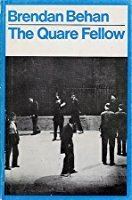First performance 19 November 1954 Adaptations The Quare Fellow (1962) | Original language English Genre Tragicomedy | |
 | ||
Characters Prison ChaplainWarder CrimminPrisoner A (Hard Case)Prisoner B (The Man of Thirty)Prisoner C (The Boy from the Island)Prisoner D (The Embezzler)The Other FellowEnoch JenkinsonAssistant HangmanShayboSecond WarderNeighbourMickserHoly HealeyChief WarderDunlavinCookHalliwell, 2nd Asst. HangmanMedical OrderlyWarder ReganEnglish VoiceFirst WarderScholarPrisoner in IsolationPrincipal WarderLiferPrison Governor Date premiered November 9, 1954 (1954-11-09) Similar The Hostage, A Taste of Honey, Oh - What a Lovely War!, Juno and the Paycock, The Playboy of the Weste | ||
The Quare Fellow is Brendan Behan's first play, first produced in 1954.
Contents
The title is taken from a Hiberno-English pronunciation of queer, meaning "strange" or "unusual". In context, the word lacks the denotation of homosexuality that it holds today, although the word 'quare' is never used in the context of sexuality. The play does feature a gay character, but he is referred to as The Other Fellow.
Plot
The play is set in Mountjoy Prison, Dublin. The anti-hero of the play, The Quare Fellow, is never seen or heard; he functions as the play's central conceit. He is a man condemned to die on the following day, for an unmentioned crime. Whatever it is, it revolts his fellow inmates far less than that of The Other Fellow, a very camp, almost Wildean, gay man.
There are three generations of prisoners in Mountjoy including boisterous youngsters who can irritate both other inmates and the audience and the weary old lags Neighbour and "methylated martyr" Dunlavin.
The first act is played out in the cramped area outside five cells and is comedic, sometimes rather like an Irish episode of Porridge. After the interval, the pace slows considerably and the play becomes much darker, as the time for the execution approaches. The focus moves to the exercise yard and to the workers who are digging the grave for the soon-to-be-executed Quare Fellow.
The taking of a man's life is examined from many different angles: his fellow prisoners of all hues, the great and the good and the prison officers.
The play is a grimly realistic portrait of prison life in Ireland in the 1950s, and a reminder of the days in which homosexuality was illegal and the death penalty relatively common (35 people were executed between 1923 and 1954, about one every 10½ months). The play is based on Behan's own prison experiences, and highlights the perceived barbarity of capital punishment, then in use in Ireland. The play also attacks the false piety in attitudes to sex, politics and religion.
Performance
The play was offered to Dublin's Abbey Theatre, but was turned down. It premièred at the Pike Theatre Club, Herbert Lane, Dublin, on 19 November 1954 to critical success. The Quare Fellow had its London première in May 1956 at Joan Littlewood's Theatre Workshop at the Theatre Royal Stratford East. On 24 July 1956 it transferred to the Comedy Theatre, London. In September 1956 the Abbey Theatre finally performed The Quare Fellow. It had such success that the Abbey's artistic director, Ria Mooney, pushed the next play back to allow The Quare Fellow to run for six weeks. Its first New York performance was on 27 November 1958 at the Circle in the Square Theatre.
Adaptation
In 1962 the play was adapted for the screen by Arthur Dreifuss and starred Patrick McGoohan, Sylvia Syms and Walter Macken. Although the film received some favourable reviews, it is not regarded as a faithful adaptation of the play.
"The Auld Triangle"
"The Auld Triangle", a song from the opening of the play, has become an Irish music standard and is known by many who are unaware of its link to The Quare Fellow.
